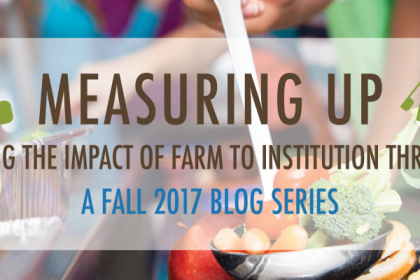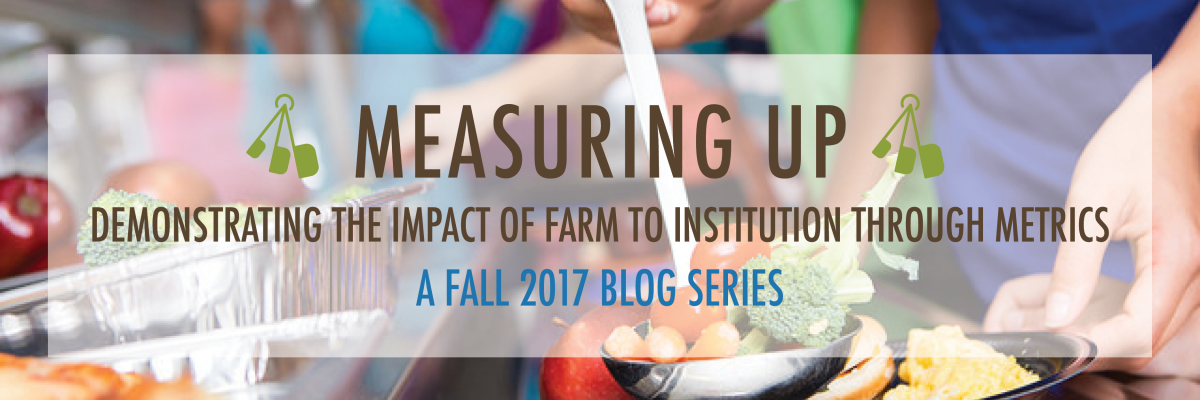
This installment was originally posted on the Farm to Institution New England blog.

Welcome to Measuring Up, a six-part blog series designed to provide an introduction to the importance of data in understanding the farm to institution landscape in New England. There are 4,628 K-12 schools, 210 colleges and universities, and 256 hospitals that provide dining services in New England. In total, they feed an estimated 3.8 million people per day [1]. This includes students, patients, visitors, faculty, and staff (institutions are among the largest employers in New England; according to each state’s Department of Labor, all but one New England state – Connecticut – has an institution or institutional system as its largest employer [2]). Institutions have the opportunity and the power to significantly impact the food system by supporting local producers and feeding their constituents fresh, healthy foods.
Establishing a baseline for local food procurement from which progress can be measured is an essential step in mobilizing the power of institutions to transform the food system. Our metrics work helps us and our partners understand the system we are trying to change. This blog series will provide an overview of the top findings from over two years of work dedicated to understanding that system and the key indicators for farm to institution success across the value chain.

Foundation of Research
FINE’s metrics work began in 2015 in order to collect, analyze, and share important data with farm to institution stakeholders in New England. Ongoing initiatives focus on three institutional sectors: K-12 schools, institutions of higher education, and hospitals.
Results of FINE’s metrics work are available through a series of reports, state profiles, an interactive dashboard, and this blog series. Data used by the FINE metrics work team comes from several national sources like the USDA’s Farm to School Census, Census of Agriculture, Local Food Marketing Practices Survey and Food Environment Atlas; Real Food Challenge; and research conducted by Health Care Without Harm and other core partners. Where important gaps in the data were identified, original surveys were designed and implemented by the FINE metrics team. These have established primary data on New England distributors, colleges and universities, and producers as they each pertain to the farm to institution market.
The information shared through this blog reflects the respondents who voluntarily participated, and not the entire New England population; survey and census data are self-reported and may conflict with other data sources. That being said, ongoing efforts are underway to perform non-respondent surveys and increase sample sizes for future data collection.

Measuring Up Installments
Each installment in this series will look at a key finding from FINE’s metrics work and explore how data can be used to tell the story of Farm to Institution efforts in New England. A new installment will be published every other week this fall, starting with this introduction.
The following topics will be discussed over the course of the series:
- When, How, and Why to Define “Local”
- Working Within the System: Institutional budgets, operational characteristics, and local food procurement
- Accessing Local Product: What products do institutions buy local and what are the barriers to increasing local procurement?
- Producer Perspectives: Who is providing institutional product?
- The Power of Institutions to Change the Food System: Impacts and data-based recommendations for achieving success
The next installment of Measuring Up will discuss how key players along the value chain are defining “local” and why understanding these different definitions is so important. See you then!
[1] K-12: U.S. Department of Education, National Center for Education Statistics, Common Core of Data (CCD) SY2012-2013 – http://nces.ed.gov/programs/digest/d14/tables/dt14_203.20.asp
Colleges: U.S. Department of Education, National Center for Education Statistics, Integrated Postsecondary Education Data System (IPEDS) – SY 2009-2010 via http://nces.ed.gov/programs/stateprofiles/index.asp
Hospitals: American Hospital Directory – “Numbers of staffed beds are taken from a hospital’s most recent Medicare cost report (W/S S-3, Part I, col.1).” – https://www.ahd.com/state_statistics.html
Hospitals: Occupancy Rate – American Hospital Association Annual Survey of Hospitals. Hospital Statistics, 1976, 1981, 1991–2011 editions. Chicago, IL. (Copyright 1976, 1981, 1991–2011: Used with the permission of Health Forum LLC, an affiliate of the AHA.) See Appendix I, American Hospital Association (AHA) Annual Survey of Hospitals. http://www.cdc.gov/nchs/data/hus/2011/116.pdf
Hospitals: Health Care Employment – Bureau of Labor Statistics, State Occupational Employment Statistics Survey, May 2014 http://kff.org/other/state-indicator/total-health-care-employment/
[2] The Maine Department of Labor specifies that this list includes the top private employers in the state.
Hannah Leighton is a Research Associate with Farm to Institution New England working with the metrics team.




